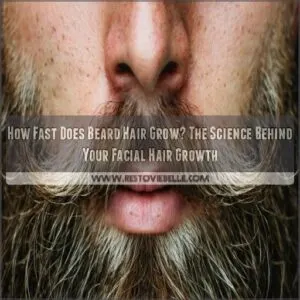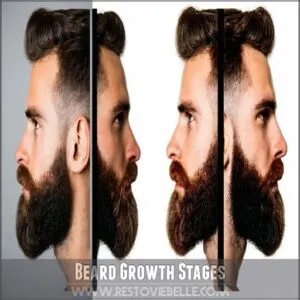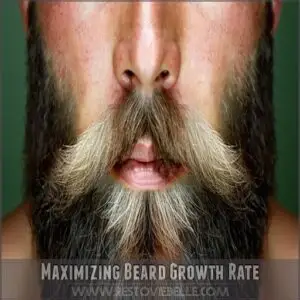This site is supported by our readers. We may earn a commission, at no cost to you, if you purchase through links.
 Beard hair grows about 0.3 to 0.5 millimeters a day, which adds up to roughly half an inch per month.
Beard hair grows about 0.3 to 0.5 millimeters a day, which adds up to roughly half an inch per month.
That means a full beard can take anywhere from 2 to 4 months to grow, depending on your genetics and hormones. Factors like stress, nutrition, and skincare also play a big role in how fast your beard fills in.
While your DNA determines the pace, you can boost growth by eating well, exercising, and keeping your skin healthy. Keep in mind, patience is key—like planting a garden, great beards thrive with care and time.
Ready to master the art of beard upkeep?
Table Of Contents
- Key Takeaways
- Beard Growth Basics
- How Fast Does Beard Hair Grow
- Beard Growth Stages
- Factors Affecting Beard Growth
- Maximizing Beard Growth Rate
- Maintaining a Healthy Beard
- Frequently Asked Questions (FAQs)
- How fast does a beard grow?
- How long does it take to grow a beard?
- Does your beard grow faster than your hair?
- How long does it take to grow a thicker beard?
- How Long It Takes to Grow A Beard as A teenager?
- How fast does beard hair grow in a week?
- What is the 3 month beard rule?
- How long would a beard grow if you never shaved?
- How long does it take for a beard to grow 1 inch?
- How to grow hair faster?
- Conclusion
Key Takeaways
- Your beard grows about 0.3 to 0.5 millimeters daily or roughly half an inch per month, but genetics and hormones greatly influence the growth rate.
- Factors like a healthy diet, regular exercise, proper sleep, and stress management can help boost your beard growth.
- The average time to grow a full beard is 2 to 4 months, with significant growth visible after about 3 months.
- Proper skincare, including cleansing, moisturizing, and exfoliating, promotes healthier and faster beard growth.
Beard Growth Basics
Your beard grows at a consistent rate of about half a millimeter each day, which adds up to roughly half an inch per month.
You’ll start seeing significant growth after two months, though genetics and hormones will influence how thick and full your beard becomes.
Facial Hair Growth Rate
Your facial hair growth rate follows a predictable pattern, typically advancing between 0.3 to 0.5 millimeters daily. That’s roughly one-third to one-half inch per month of steady facial hair progress.
While your daily growth might seem slow, this facial hair speed is actually slightly faster than scalp hair. Understanding beard growth science can help you better care for your facial hair.
Your beard’s growth cycle moves through distinct phases, with active growth lasting several years before resting.
Average Time to Grow a Beard
Most men find a full beard takes two to four months. Beard growth rate averages around half an inch per month, influenced by individual growth patterns.
Facial hair grows about 0.3 to 0.5 millimeters daily. Beard development time varies, but you can expect noticeable beard thickness within three months.
Understanding beard growth basics is important for men looking to grow a healthy and full beard. How fast your beard grows depends on your average beard growth speed and facial hair growth rate.
Factors Influencing Growth
Several factors affect beard growth rate.
Genetics and hormone levels play a starring role, influencing how quickly and thickly your beard grows.
Nutrient intake and sleep patterns also matter.
Even environmental factors can impact your beard growth.
So, while genetics lays the groundwork, your diet, sleep, and surroundings contribute too.
How Fast Does Beard Hair Grow
So, you’re curious about your beard’s growth potential? Let’s get down to the nitty-gritty: how fast does beard hair actually grow? Facial growth varies, but your beard growth rate clocks in around 0.3 to 0.5 millimeters per day—that’s roughly one-third to one-half inch per month.
Think of it like this:
- Week 1: You’re rocking some stubble.
- Month 1: A noticeable fuzz appears.
- Month 2: You’re on your way to a full beard (maybe!).
Several factors influence your personal beard hair speed, from genetics and hormones to age and ethnicity. Hair follicles play a key role, determining your beard density and overall growth patterns. Understanding the beard growth factors can help you better assess your unique growth potential.
While the average beard growth speed is consistent, individual results differ. Some guys sport a full beard in weeks, while others need months. Patience is key. Your beard growth journey is unique. Don’t compare your progress to others.
Beard Growth Stages
You’ll notice your beard develops through distinct phases, from initial stubble to a full, majestic mane (or something close to it).
Each stage has unique characteristics, and understanding them helps you manage expectations and tailor your beard care routine effectively.
Initial Stubble Stage
The initial stubble stage, typically within the first week, reveals your beard’s blueprint.
Noticeable stubble emerges, showcasing early growth patterns and hair texture.
While the full beard density isn’t apparent yet, this stage hints at your facial hair growth rate and how fast your beard grows, influencing how it complements your facial shape.
Stubble care is minimal at this point; just observe your beard growth speed.
Visible Growth Pattern Stage
After that initial stubble, you’ll notice a more defined growth pattern emerge around week two.
This stage reveals your beard’s natural tendencies—growth patterns, hair texture, and beard density—influenced by your facial structure.
You’re starting to see how fast your beard grows, giving you a glimpse of your average beard growth speed and beard growth rate, some call this stubble management, but it’s more about observing your beard’s blueprint.
This visible shift sets the stage for thicker growth, but patience is still key.
Full Beard Development Stage
Around week four, you’ll notice your beard filling in, revealing its true potential. This stage showcases your unique growth patterns and hair texture, hinting at your future full beard.
Consider your facial shape and desired beard style as you observe your average beard growth speed and density. To achieve a thicker beard, understanding beard growth techniques is essential for maximizing your beard’s potential.
This exciting phase reveals the blueprint for your personalized beard journey. Your beard growth rate, about half an inch per month, contributes to a thicker appearance.
Maintenance and Trimming Stage
So, your beard’s reached a respectable length—now what? This is the maintenance phase, where consistent trimming shapes your beard and keeps it sharp.
- Invest in quality trimming tools.
- Learn basic beard trimming tips.
- Explore beard oil benefits for healthy growth.
- Add skin exfoliation to your routine.
- Understand your beard growth rate to maintain your desired length.
This stage is all about facial hair maintenance and maximizing your beard growth per month.
Factors Affecting Beard Growth
Your beard’s growth rate isn’t just about how much you trim it.
It’s a complex interplay of genetics, hormones, lifestyle choices, and overall health.
These factors influence everything from the thickness of your whiskers to how quickly (or slowly) they sprout.
Genetics and Ethnicity
While you might rock a killer stubble at two weeks, your buddy might still be baby-faced.
Genetics and ethnicity play a huge role. Your family’s inheritance patterns and ethnic variations influence your beard growth rate and hair texture.
Some racial differences mean thicker beards for some, while others have slower facial hair growth rate due to their genetics. Understanding facial hair patterns can help explain these variations in beard growth among different ethnic groups.
Hormones and Age
Beyond your family tree, hormones and age substantially impact your beard growth rate.
Testosterone levels, converting to DHT, are key players in this game.
Here’s the breakdown:
- Puberty stages kickstart testosterone production.
- Peak beard growth speed often hits in your 20s and 30s.
- Hormone imbalance can throw things off.
- Age factors influence growth patterns, sometimes slowing things down, due to age.
Lifestyle and Nutrition
Your diet and lifestyle play a vital role in beard growth. A balanced diet, packed with vitamins like A, B, and C, provides essential building blocks.
Prioritize a nutritious diet rich in healthy fats and protein for maximum growth. Regular exercise, sufficient sleep (around 7-8 hours), and stress reduction techniques contribute to a healthy lifestyle and, indirectly, a fuller beard.
Consider meal planning to maintain consistent vitamin intake and maintain healthy sleep patterns.
Medical Conditions and Stress
If your beard growth feels stalled, medical conditions and stress might be why.
Hormone imbalances, alopecia barbae, or prolactinoma can slow progress.
Stress effects like elevated cortisol hinder growth cycles.
Watch for signs:
- Sudden beard loss.
- Patchy spots or thinning hair.
- Persistent skin irritation.
- Slow, uneven growth.
- Brittle texture or shedding.
Seek treatments for restored skin health.
Maximizing Beard Growth Rate
If you’re aiming to speed up your beard growth, focusing on diet, exercise, and skincare can make a big difference.
Simple changes like eating nutrient-rich foods, managing stress, and maintaining healthy skin help support faster, fuller growth.
Balanced Diet and Nutrition
A healthy diet can supercharge your beard growth rate.
Load up on protein sources like eggs and nuts while balancing vitamins and minerals. Add healthy fats to hydrate beard hair and boost growth.
For convenience, supplements offer support.
Here’s a guide:
| Nutrient | Benefit | Food Source |
|---|---|---|
| Vitamin D | Growth Support | Salmon, Mushrooms |
| Protein | Stronger Beard | Eggs, Chicken |
| Omega-3 | Hydration Boost | Fish, Walnuts |
Exercise and Stress Management
Sweating through mindful exercise or nailing your workout routines isn’t just great for fitness goals—it boosts testosterone levels, too, which directly impacts your beard growth rate.
Using the right exercise equipment can help maximize the effectiveness of your workouts.
Stress reduction methods like yoga benefits your body’s ability to grow facial hair by curbing cortisol, a hormone that stunts growth.
When stress fades and you stay active, beard growth speed can improve noticeably.
Protecting Skin and Hair
Healthy skin fuels faster beard growth.
Cleanse daily, moisturize, and protect with sunscreen to keep pores clear and prevent dryness.
Beard oil benefits both hair and skin by locking in hydration and boosting hair follicle health.
Exfoliate weekly to enhance beard growth speed and tackle buildup.
Strong skin care habits enhance your facial hair growth rate effectively over time, with the help of beard oil.
Maintaining a Healthy Beard
Keeping your beard healthy means more than just letting it grow; it requires consistent care and attention.
From proper trimming to cleaning and skin care, a well-maintained beard enhances both appearance and skin health.
Regular Trimming and Shaping
Trimming helps manage uneven growth and keeps your beard looking sharp, even as your beard growth speed varies.
Use shaping tools to define your edges and avoid the dreaded neckbeard—neckline trimming is key.
Regular trims don’t slow how fast a beard grows but instead highlight its fullness.
For effective facial hair maintenance, embrace edge control and consistency for a polished look.
Washing and Conditioning Routine
Using a beard shampoo keeps your hair clean without stripping natural oils, unlike regular facial cleansers. Follow up with a hair conditioner to soften strands and keep them manageable.
Washing boosts your beard growth speed by promoting healthier skin underneath. For best results, using a beard care product is essential.
Stick to a routine—how fast your beard grows depends partly on consistent care. Clean beard, faster growth, better confidence!
Exfoliating and Massaging Skin
Exfoliating your skin isn’t just a fancy add-on—it’s essential for beard health. A good beard scrub clears dead skin, promotes skin renewal, and keeps the pores beneath your beard clean.
Using a beard care product can help maintain a healthy skin environment for beard growth.
Combined with facial massage, it boosts blood flow, stimulates beard growth, and enhances your facial hair growth rate. Pay attention to these small steps; they impact your beard growth speed!
Common Beard Growth Concerns
Struggling with beard thinning or patchy growth? Slow regrowth and itchy skin are common hurdles, but understanding factors affecting beard growth can help.
Ingrown hairs often result from improper shaving or trimming. To boost your beard growth speed, focus on a healthy routine.
Know that the average beard growth speed varies by genetics, ensuring how fast your beard grows is uniquely yours.
Frequently Asked Questions (FAQs)
How fast does a beard grow?
Ever wonder how quickly that stubble turns into a beard?
Facial hair grows about 3 to 5 millimeters daily—that’s nearly half an inch a month.
Genetics, age, and lifestyle can nudge this figure either way.
How long does it take to grow a beard?
Growing a full beard usually takes 2 to 4 months.
Genetics, age, and hormones play significant roles, but expect visible growth stages—stubble in a week, shaping at two months, and maintenance beyond that.
Does your beard grow faster than your hair?
Your beard grows at the same speed as your scalp hair—about 3 to 5 millimeters daily.
But hormones like testosterone make beard hair appear thicker and denser, creating the illusion of faster growth.
How long does it take to grow a thicker beard?
It usually takes 2-4 months to grow a thicker beard, depending on genetics, hormones, and age.
Patience is key—nourish it with a balanced diet, consistent grooming, and proper hydration to maximize thickness and health.
How Long It Takes to Grow A Beard as A teenager?
Growing a beard as a teenager typically takes at least 2-4 months, depending on your genetics and hormones.
Expect slower, patchy growth at first, but patience and proper care can help maximize your progress.
How fast does beard hair grow in a week?
In a week, your beard hair grows about 2–3 millimeters, depending on genetics, hormones, and age.
That’s roughly the thickness of two pennies stacked—small progress, but it adds up over time!
What is the 3 month beard rule?
On average, beard hair grows about half an inch monthly, and the 3-month beard rule pushes patience.
Let your beard grow untouched for 90 days to reveal its natural pattern, shape, and potential fullness.
How long would a beard grow if you never shaved?
If you never shaved, your beard could grow around 6 inches in a year, given facial hair grows about 3-5 millimeters daily.
After 2-6 years, growth stops during the hair’s resting phase.
How long does it take for a beard to grow 1 inch?
Growing a beard to 1 inch takes roughly two to three months since facial hair grows about 3 to 5 millimeters daily. Patience, good grooming, and a healthy lifestyle make the process smoother.
How to grow hair faster?
Boost hair growth by eating a protein-rich diet, getting 7-8 hours of sleep, exercising regularly, and managing stress.
Nourish follicles with vitamins like biotin, avoid harsh products, and stay consistent with a proper care routine.
Conclusion
Growing a beard is like tending a slow-growing tree—patience and care make all the difference.
While beard hair grows about 0.3 to 0.5 millimeters daily, factors like genetics, hormones, nutrition, and stress can speed things up or slow them down.
Stick to healthy habits like eating well, exercising, and maintaining a proper skincare routine to boost growth.
Ultimately, understanding how fast beard hair grows helps you set realistic expectations while you work toward the perfect beard.













